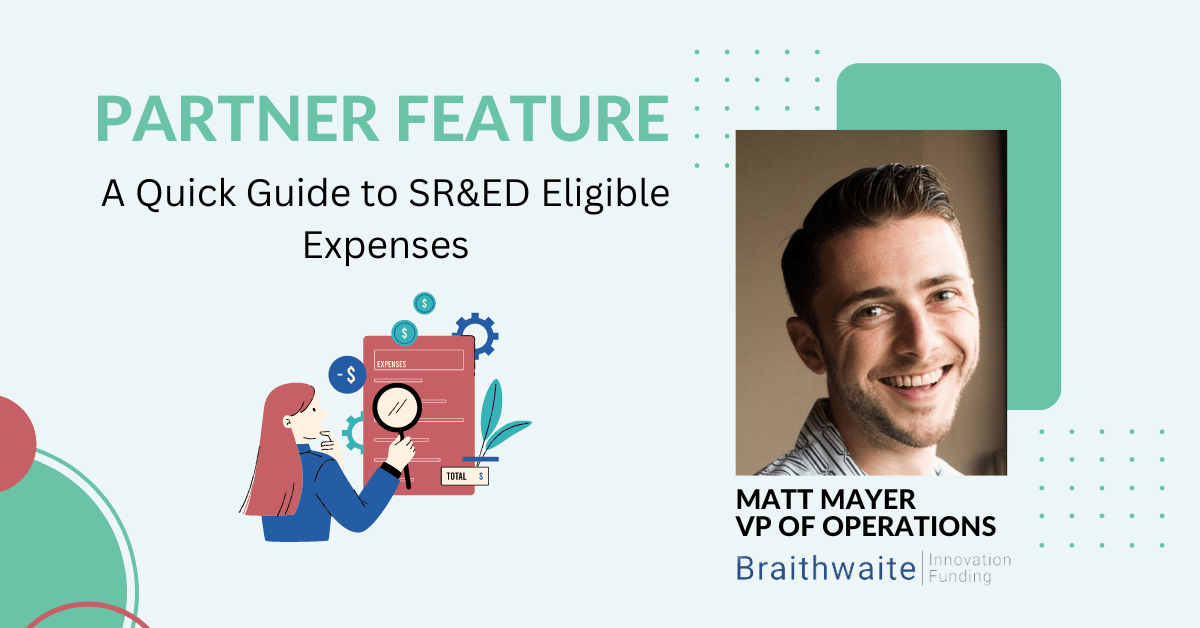Reading time: 4 minutes
Are you looking to increase your capital stack and diversify your funding in 2023? For companies across Canada, knowing how to take advantage of government initiatives like the Scientific Research and Experimental Development (SR&ED) program are essential to maximizing your capital and, in the case of SR&ED applicants, furthering your project objectives. Introduced in 1983, the SR&ED program remains the largest government initiative for research and development (R&D) and is aimed at furthering innovation and scientific advances across the nation. In order to alleviate some of the costs and related pain points experienced by business owners and researchers, SR&ED awards tax credits and refunds to eligible initiatives.
Those looking to maximize their SR&ED returns and receive the most credit possible need to know how to calculate expenditures and eligible costs accurately. Missing key details open the door to a CRA audit that delays your funding further. If you’re looking to file for SR&ED for 2022 you’ll want to keep the following in mind when calculating your expected refund:
Why Are Accurate Calculations So Important?
Companies have up to 12 months following the income tax reporting deadline to submit SR&ED applications, making it essential to ensure that your T661 is as accurate as possible. Claims are evaluated on an annual basis, but unlike other government grants or venture funding, it’s important to know that successful applicants will face a waiting period before receiving their SR&ED refund or incentive. This waiting period can range from a few weeks to months (typically within 180 days) or, in the case of your application being submitted to a CRA review, up to a year after applying. Making sure you have the most accurate information possible is one of the best ways to avoid a review and to ensure you receive your capital as quickly as possible.
As a general reminder, it’s important to be aware that SR&ED incentives are designed to support businesses, projects, and activities in the following categories:
- Basic research
- Applied research
- Experimental Development
- Activities directly tied to R&D
Core areas evaluated in SR&ED applications include:
Payroll
Payroll is an essential expenditure that allows your operations to continue to drive forward. Under SR&ED guidelines, you are able to claim salaries for R&D involved parties. Before you do so, make sure you have clear documentation that verifies how many hours each team member is involved in related activities, and then multiply the respective number by the total number of hours worked (tip: utilize hour tracking software for verification purposes) for your final number. If you have salaried team members involved in your project, divide the annual wage by hours worked during that fiscal year for the balance amount to be claimed.
Contractor Expenses
The SR&ED program allows you to claim up to 80% of the cost of Canadian-based contractor expenses. Keep detailed records of all contractors used, for what purpose, and the total expenditure within that calendar year to make sure your application is accurate.
Cost of Materials
While the SR&ED program doesn’t accommodate all material costs, the materials used to craft prototypes, as well as those consumed during experimentation and active research, are eligible. It is vital to ensure that your procurement department has detailed records and materials lists to verify any claims should your claim be submitted for review.
R&D Facilities
A common misconception about SR&ED-eligible projects is that they are specific to laboratory environments. While many projects within the biotechnology and pharmaceutical sectors do take place in labs, many projects are developed in different environments. If your facilities are essential for R&D purposes, you are able to claim a portion of rent and overhead costs as part of your refund.
Supplementing Your SR&ED Incentives
SR&ED refunds are a valuable resource for increasing your accessible capital, but they are not the only government-based subsidy that you can claim. The Industrial Research Assistance Program (IRAP), Interactive Digital Media Tax Credit and other related initiatives give companies across Canada access to funding aimed at supporting innovation sustained here at home.
Calculate Your Refund With Confidence
Knowing how much you can anticipate your SR&ED refund to be is essential when it comes to forecasting, securing additional capital from investors, and laying a viable path forward operationally. To help reduce confusion and give you a rough estimate of what to expect, Venbridge has created an easy-to-use calculator for SR&ED applicants. Partnering with an experienced SR&ED consultancy is an additional point of consideration, as doing so may help you maximize your return and avoid missing the full potential of your refund.
Financing With Venbridge
Venbridge knows that having readily accessible capital is a necessity for startups and R&D companies all year-round. While SR&ED incentives are an incredibly valuable asset to add to your resources, sometimes long waiting periods can lead to significant difficulty for businesses that may face stoppages during key points of development. Financing your SR&ED tax credit with a trusted lender like Venbridge gives you cash flow when it matters most and removes the burden of handling essential growth activities like:
- Expanding your team
- Product rollout and market launches in Canada
- Enhanced product and/or service development
- Handling material costs, and more.
With capital ready to reach your bank account as quickly as two business days, Venbridge is proud to support Canadian innovation and to provide you with a trusted path forward.




